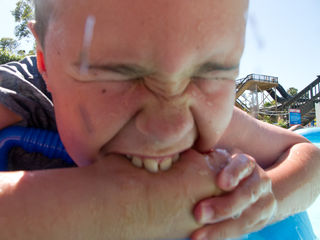Autism
Making Severe Autism Visible
Two new projects show what significant impairment looks like.
Posted December 1, 2015
In September, I published excerpts from Facebook posts by parents describing the tremendous impairments and challenges of their severely autistic children. By no means am I the only one engaged in this type of documentation: several well known bloggers, including Autism Daddy, Harold Doherty and David Royko – also write on this topic. But, for some reason, severe autism is still constantly minimized and misrepresented, its significant neurological deficits even recast as the failure of parents to understand and meet their children’s needs.
Because words are not enough, particularly when it comes to a condition that is so foreign and unimaginable to those who have not interacted with it firsthand. I’ve always thought that what we needed, what might really help advance dialogue

among the public, policy makers, and all the stakeholders in the autism community is somehow showing what we’re talking about when we talk about low-functioning autism.
Now, two projects are underway with that exact goal. The first is the book Immersed: Our Experience with Autism, by Bruce and Valerie Hall.
Accompanying Valerie’s short pieces about raising twin boys with severe autism are over 170 pictures by Bruce, a legally blind photographer whose work has been featured in textbooks, magazines, and several museums, including the National Museum of Natural History at the Smithsonian. Bruce captures his sons’ joyful moments, but he also depicts their isolation, their self-injury, their agitation, and their severely restricted interests.
The second is the documentary Aging Out by filmmaker and parent Melissa Collins-Porter, which is about the crippling lack of services available to young autistic adults once they reach the age of 21. Collins-Porter features teenagers with a range of impairment in her trailer – some are verbal, some aren’t – but all have significant intellectual disability (as does 40% of the autistic population) and will require a lifetime of significant care.
Because the mainstream media tends to focus on positive stories – like autistic kids who kick field goals, sell their art, or perform with celebrities – these projects are seeking support from the public. Even if you can’t help, please watch the trailer and check out the sample book pages. Perhaps if these are widely circulated we can start acknowledging the tens of thousands (or more) of permanently and profoundly impaired autistic children and adults – who suffer from intellectual disability, minimal language, and dangerous behaviors, including aggression, self-injury, property destruction, pica and elopement – and stop pretending that functioning is a fluid dimension because, as one self-advocate put it, she is “‘high functioning’ one moment and ‘low functioning’ the next.” High and low functioning are obviously not the most technical terms, but they serve an important purpose in identifying groups with vastly different challenges, prognoses, and support needs. As the government crafts policy that affects the therapeutic, educational, vocational, and residential services available to all those with developmental disabilities, it is pivotal that these differences are recognized, respected, and accommodated.


